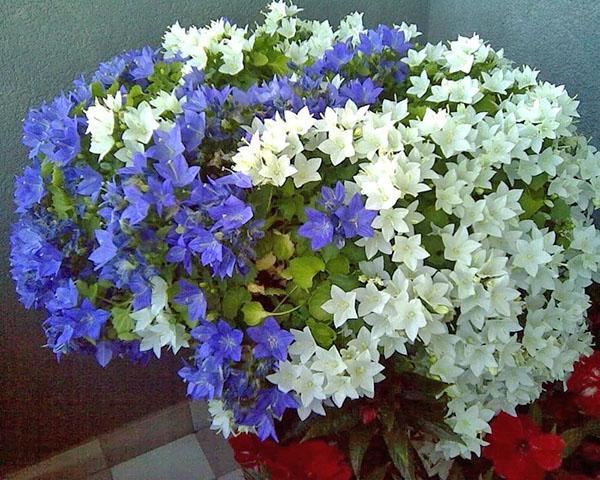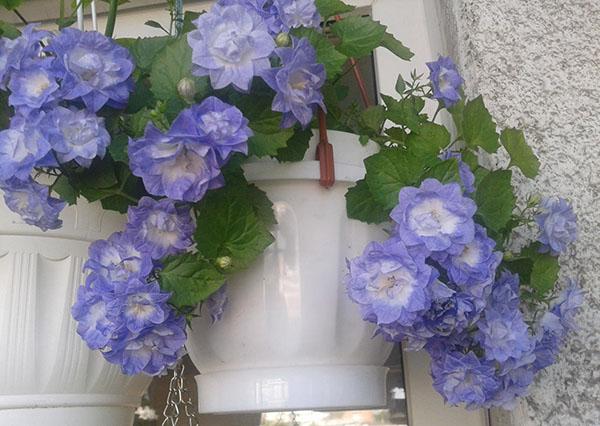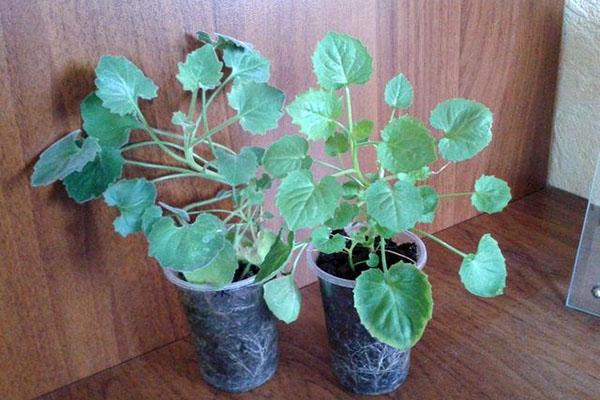Caring for campanula at home: growing rules, reproduction, diseases
 Indoor flowers at all times were considered an original decoration of a living room. Therefore, it is not surprising that caring for campanula at home attracts many flora fans. Cute bells not only delight the eye, but also fill the house with happiness. It is not for nothing that the flower is sometimes called "Bride and Groom", which indicates the most important celebration in life. Let's try to feel the beauty of this plant and understand the intricacies of its cultivation.
Indoor flowers at all times were considered an original decoration of a living room. Therefore, it is not surprising that caring for campanula at home attracts many flora fans. Cute bells not only delight the eye, but also fill the house with happiness. It is not for nothing that the flower is sometimes called "Bride and Groom", which indicates the most important celebration in life. Let's try to feel the beauty of this plant and understand the intricacies of its cultivation.
The tenderness of the petals and intricate shapes

However, the people call the flower:
- chebotki;
- bells;
- birdwort;
- chenille;
- family happiness.
Biologists classify more than 400 campanula species that are grown both outdoors and at home. The most popular variety of indoor bells is Campanula Equifolia. It is a perennial plant with dangling branches reaching about 30 cm in length. Since it is quite simple to care for the campula at home, it adorns many living quarters and courtyards.
 The alternate leaf plates, long-petiolate, are colored light green. The edges are serrated. The length of the leaf varies from 3 to 7 cm. The maximum diameter of the buds reaches 4 cm.
The alternate leaf plates, long-petiolate, are colored light green. The edges are serrated. The length of the leaf varies from 3 to 7 cm. The maximum diameter of the buds reaches 4 cm.
They are originally collected in paniculate inflorescences and painted in the following colors:
- pale pink;
- snow-white;
- lilac;
- lilac;
- blue.
They are often formed at the tips of graceful shoots that look original against a background of lush greenery.
Despite its attractive appearance, after a few years the plant loses its decorative effect.
Caring for a companula at home: basic principles and expert advice
 As you know, an exquisite bell does not require special attention. It is enough to fulfill the basic principles of caring for it and the house will always be decorated with live "bouquets of joy".
As you know, an exquisite bell does not require special attention. It is enough to fulfill the basic principles of caring for it and the house will always be decorated with live "bouquets of joy".
In order for the flower to adapt to the new room, it is left for several days in an old pot. After that, they begin to transplant the campanula into a new spacious container.
Since the root system of the flower grows rapidly, a loose soil is prepared from the following components:
- peat;
- leafy land;
- humus;
- sand.
Each of them is taken in the same quantity. Then a drainage layer is placed on the bottom of the container, which facilitates the flow of oxygen and allows excess liquid to pass through. Put the prepared substrate on top of it, about half of the container. Then the plant is poured abundantly with water, after which it is carefully removed from the container. The bottom layer of the horse system, about 5 mm, is cut with a sharp knife. The same cuts are made on the sides. The plant is placed in a new container, the substrate is added, compacted and moderately moistened with a spray bottle. The transplanted flower is transferred to a cool room away from direct sunlight.
In order for the plant to quickly take root in a new pot, it is advisable not to damage the earthen lump on the rhizome.
Choosing a suitable area
 In order to conveniently care for the campanula at home, you need to choose the right place for its habitat. Despite the plant's special light-loving nature, it does not like bright sunlight. Therefore, in the summer, the flower is transferred to the shaded areas of the room. The best option for placing the bell is western and eastern windows. In the warm season, campanula is taken out into the fresh air. The flower is returned to its original habitat at the end of September, if climatic conditions permit.
In order to conveniently care for the campanula at home, you need to choose the right place for its habitat. Despite the plant's special light-loving nature, it does not like bright sunlight. Therefore, in the summer, the flower is transferred to the shaded areas of the room. The best option for placing the bell is western and eastern windows. In the warm season, campanula is taken out into the fresh air. The flower is returned to its original habitat at the end of September, if climatic conditions permit.
The plant perfectly tolerates temperature fluctuations ranging from 15 ° C in winter to 25 ° C in summer.
Breeding secrets
 Growing a campanula from seeds at home is not at all difficult if you follow the basic rules. The process begins in early spring by preparing suitable containers or disposable cups. Fill them with dry and damp substrate. Lightly tamp in order to properly decompose the planting material. Then the miniature seeds of the room campanula are carefully placed and slightly moistened. The procedure is carried out using a sprayer, otherwise they will not rise. When sprouts appear on which there will be at least 3 leaves, the plant is transplanted into new pots. Over time, the culture will take root, and the cherished bells will appear on it.
Growing a campanula from seeds at home is not at all difficult if you follow the basic rules. The process begins in early spring by preparing suitable containers or disposable cups. Fill them with dry and damp substrate. Lightly tamp in order to properly decompose the planting material. Then the miniature seeds of the room campanula are carefully placed and slightly moistened. The procedure is carried out using a sprayer, otherwise they will not rise. When sprouts appear on which there will be at least 3 leaves, the plant is transplanted into new pots. Over time, the culture will take root, and the cherished bells will appear on it.
To propagate campanula using cuttings, several simple procedures are performed:
- a branch with several leaf plates is cut from the bottom of the plant;
- place it for 10 hours in a weak solution of potassium permanganate;
- when the roots appear, the shoot is transferred to a container with clean water;
- prepare a substrate from sand and peat;
- sprouts are planted to a depth of about 3 cm;
- cover the container with plastic wrap;
- moisturize once a week.
The rooted plant is transplanted into a beautiful pot, looking forward to its flowering. An adult campanula is propagated by dividing the rhizome. It is carefully cut into several pieces, and then planted in a separate container. If necessary, the plant is fed with special fertilizers.
Preparing a flower for a state of rest
 Despite the lush bloom and lush greenery, the indoor bell stops developing in autumn. Therefore, it is important to understand how the campanula winters in order to provide it with competent care. First of all, the elongated branches are cut, leaving only 10 cm in length. Then the flower is transferred to a bright but cool room. The bell is watered no more than 2 times a month. In the spring, the container is brought into heat, dried shoots are removed and watering... If the plant has grown too much, it is transplanted into a more spacious container.
Despite the lush bloom and lush greenery, the indoor bell stops developing in autumn. Therefore, it is important to understand how the campanula winters in order to provide it with competent care. First of all, the elongated branches are cut, leaving only 10 cm in length. Then the flower is transferred to a bright but cool room. The bell is watered no more than 2 times a month. In the spring, the container is brought into heat, dried shoots are removed and watering... If the plant has grown too much, it is transplanted into a more spacious container.
Possible problems during cultivation
 How sad that even such a delicate flower can suffer from fungal diseases. They often appear due to improper watering. In addition, the scale insect and spider mite sometimes settle on the campanula. It is not always easy to notice them, so all parts of the plant are regularly examined. If pests are identified, the leaves and shoots are washed under running warm water or treated with a special substance.
How sad that even such a delicate flower can suffer from fungal diseases. They often appear due to improper watering. In addition, the scale insect and spider mite sometimes settle on the campanula. It is not always easy to notice them, so all parts of the plant are regularly examined. If pests are identified, the leaves and shoots are washed under running warm water or treated with a special substance.
It often causes panic in many if the campanula dries up. What to do in such a situation? First, they try to determine the cause. It could be poor lighting or dry air. Having eliminated these problems, the flower will regain its magnificent "forms".
 In some cases, the question arises: why Campanula does not bloom, despite proper care.
In some cases, the question arises: why Campanula does not bloom, despite proper care.
However, there are several rules to consider:
- the flower should not be touched during the growing season;
- in early spring, the plant needs to be fed;
- during flowering, campanula needs sufficient lighting.
Violation of these conditions leads to a slowdown in flower growth. As you can see, with proper care, the campanula will definitely decorate the living room with graceful bells of different colors. Why not grow such a miniature pleasure garden?